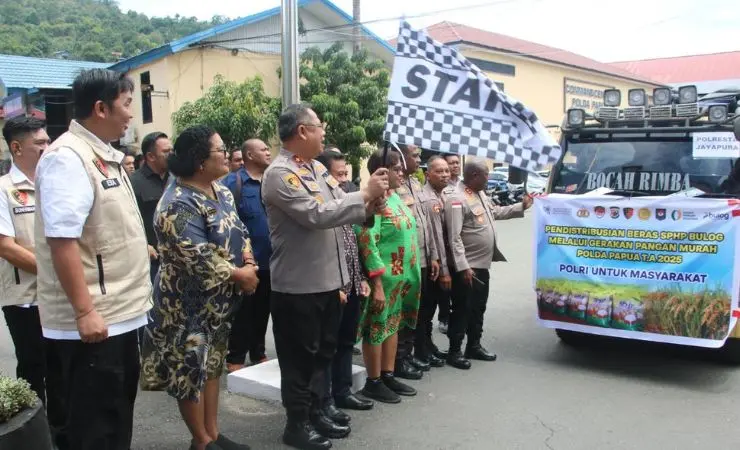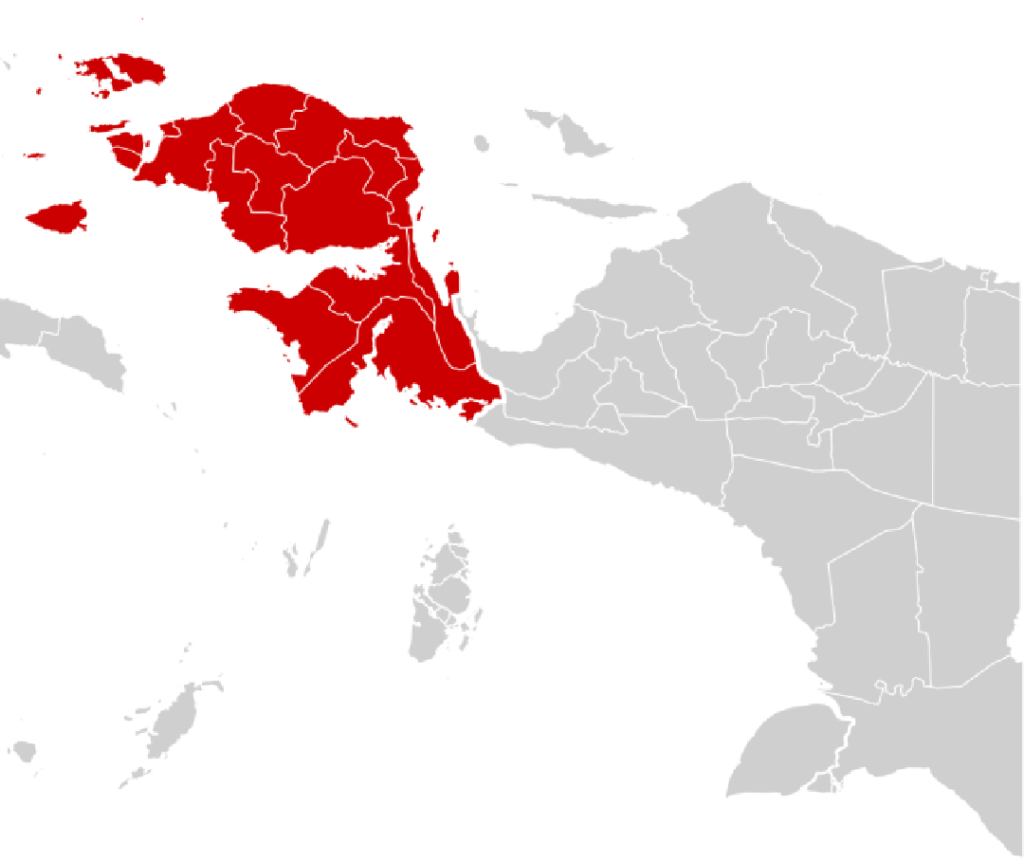When November arrives in Papua, a familiar tension settles quietly into the everyday lives of the people. Across the mountains, valleys, and coastal towns of Papua, Papua Tengah (Central Papua), and Papua Pegunungan (Highland Papua), families begin preparing for Christmas and New Year—two of the most important holidays in the region. While communities anticipate celebrations filled with worship, music, dancing, and shared meals, they also brace for something far less joyous: the seasonal surge in food prices. In many parts of Papua, the weeks leading to the holidays are marked by fluctuating rice prices and unpredictable supply lines. The region’s rugged geography, limited transport routes, and high logistical dependency make it particularly vulnerable to market instability. Against this backdrop, the role of government interventions becomes indispensable, especially when it involves rice—the single most essential staple in the Papuan diet.
This year, the Papua Regional Police (Polda Papua), working hand in hand with Perum Badan Urusan Logistik (Logistics Affairs Agency, or Bulog) and the Papua Food Task Force (Satgas Pangan), undertook a significant and highly coordinated operation to protect consumers during this critical period. Their mission: distribute 165 tons of Stabilisasi Pasokan dan Harga Pangan (Stabilization of Food Supply and Prices, or SPHP) rice across three provinces ahead of the year-end holidays. The operation, widely reported by Antara News, Seputar Papua, Koran Papua, RRI Papua, Kabar Papua, Papua Antara, and other local media outlets, reflects a growing recognition that in Papua, food security must be approached not only through economic planning but also through strong interagency collaboration.
What follows is a detailed narrative of how this intervention unfolded, why it matters, and what it signals for the future of food governance in one of Indonesia’s most geographically complex regions.
Seasonal Pressures: Why Rice Prices Spike Before Christmas and New Year
In Papua, the build-up to the holiday season is as predictable as it is challenging. As December nears, thousands of families from the highland villages of Wamena and Yahukimo to the coastal neighborhoods of Jayapura and Merauke prepare for church gatherings, communal feasts, and long-awaited family reunions. Such preparations naturally increase the demand for rice. But unlike other provinces where supply chains are supported by extensive road networks and accessible ports, Papua faces logistical hurdles that few other regions in Indonesia experience on such a scale.
Terrain becomes a determining factor. Many districts in Papua Pegunungan are reachable only by small aircraft. Bad weather—heavy rain, low clouds, or poor visibility—can ground flights for days. In Papua Tengah, trucks carrying rice must navigate hills, gravel roads, or muddy slopes that become particularly dangerous during the rainy season. Even in Papua’s urban areas, loading and distribution schedules often depend on sea routes that can be disrupted by storms.
All of these factors combine to create a fragile equilibrium between supply and demand. A single delay can cause market prices to surge beyond affordable levels, especially in remote highlands where transportation costs are already high. These fluctuations can be significant enough to affect household budgets and even community cohesion, particularly when economic strain overlaps with peak festive seasons. Traders, too, may exploit such conditions by raising prices or withholding stock in hopes of selling at higher margins. In this context, interventions like the SPHP rice program play a crucial role in stabilizing markets.
A Coordinated Multi-Province Operation: Polda Papua Takes the Lead
To address the anticipated inflationary pressures, Polda Papua initiated a region-wide distribution of 165 tons of SPHP rice—a quantity strategically allocated across three provinces most in need of price stabilization. Rather than relying solely on economic agencies, the police took an active leadership role, ensuring both logistical efficiency and regulatory enforcement.
According to reports from various media sources, the operation began on November 5, 2025. It involved careful planning sessions with Bulog, transport coordinators, district market regulators, and local governments. Polda Papua then mobilized officers to supervise loading operations at Bulog warehouses, oversee deliveries, and monitor price compliance. Police presence was especially crucial in highlands and remote districts, where logistical disruptions and pricing irregularities are more common.
The rice was distributed to a wide range of locations, including local markets, community distribution posts, cooperatives, and police-managed public service tents. In urban centers like Jayapura and Nabire, officers provided on-site oversight to ensure SPHP rice was labeled correctly and sold at government-regulated prices. In the highlands, distribution required even greater effort. Deliveries had to be coordinated with pilots, village leaders, and cargo teams to ensure rice reached communities where price spikes typically occur first.
The operation’s scale and precision underline a key development: Polda Papua is not merely a law enforcement body but a vital part of the region’s broader economic resilience strategy.
Bulog’s Assurance: Papua’s Stock Strong at 22,000 Tons
A central question during such large-scale interventions is whether supply is sufficient to support both ongoing consumption and stabilization efforts. Perum Bulog addressed this concern decisively by confirming that the Papua region held approximately 22,000 tons of rice stock, a figure more than enough to support the 165-ton release without disrupting normal supply flows.
This assurance mattered because stability is not only about distributing rice—it is also about maintaining confidence. When communities know that supply is secure, panic buying decreases, traders are less likely to mark up prices, and market conditions remain calmer. Bulog also reinforced that SPHP rice must be sold at the government’s Harga Eceran Tertinggi (Highest Retail Price, or HET), instructing residents to report any pricing violations. This created a layer of community-driven oversight that complemented Polda Papua’s enforcement activities.
Bringing Rice to the People: Ground-Level Distribution Across Diverse Terrain
One of the most compelling aspects of the distribution effort was the way it was tailored to Papua’s geographical and cultural landscape. Rather than relying on a one-size-fits-all method, Polda Papua diversified its distribution channels to match the region’s conditions. In coastal cities, rice was delivered to markets where residents could purchase SPHP rice directly from regulated stalls. In more isolated areas, temporary distribution posts were set up at community centers and police tents, where officers ensured orderly distribution.
In the highlands, where traditional logistics often falter, officers collaborated with local leaders and volunteers to move rice through narrow valleys and mountain footpaths. These localized efforts ensured that rice did not simply arrive in central hubs but reached villages where people were most at risk of price hikes. Reporters noted that families often waited patiently at distribution points, relieved that rice was reaching them before the holiday season’s peak prices set in.
These scenes—lines of residents gathering with shopping bags, police overseeing distribution, and Bulog staff coordinating supply—highlight the essence of the SPHP initiative: not just economic stabilization, but also the strengthening of trust between the state and its citizens.
Supporting the National “Gerakan Pangan Murah” Program
The distribution aligns closely with Indonesia’s national Gerakan Pangan Murah (Cheap Food Movement, or GPM) program, which aims to ensure price stability and protect vulnerable households during periods of high demand. Papua’s execution of the program demonstrates how national policy must be adapted to local conditions. Whereas some provinces may rely purely on civilian agencies, Papua requires stronger interagency collaboration due to its geography and logistical constraints.
The involvement of Polda Papua reinforces the lesson that food governance is not just about markets—it is about logistics, security, community engagement, and enforcement. When these elements work in harmony, programs like SPHP and GPM can deliver tangible and timely results.
A Strong Enforcement Component: Preventing Price Manipulation
One of the critical functions of the police in this initiative was enforcing price regulations. SPHP rice is meant to be affordable, but without oversight, it can be diverted, repackaged, or resold at higher prices. The Papua Food Task Force (Satgas Pangan) called on residents to report instances where SPHP rice exceeded the HET set by the government.
Police monitored markets closely, inspected trader stocks, and investigated reports of hoarding or unauthorized resale. Their presence deterred potential violations, ensuring that the SPHP program remained effective. This served as a reminder that food stability requires both supply and accountability.
Economic and Social Impacts: Beyond Just Rice
While the distribution of 165 tons of rice may appear small in proportion to Papua’s overall annual consumption, its strategic timing and targeted deployment delivered significant benefits. By stabilizing rice prices, the intervention prevented broader inflation across multiple commodities, since rice often serves as a benchmark for food pricing. Families were able to allocate more of their income toward holiday needs, school fees, nutritional supplements, and other essentials.
Socially, the operation strengthened trust between communities and the government. In a region where logistical isolation can contribute to economic vulnerability, interventions like this serve as practical demonstrations of the state’s commitment to public welfare. This, in turn, contributes to social harmony and a more resilient local economy.
Conclusion
The distribution of 165 tons of SPHP rice by Polda Papua was far more than a logistical exercise—it was a coordinated effort to safeguard the well-being of communities across three provinces at a critical time of the year. Through a combination of strong planning, interagency cooperation, ground-level engagement, and vigilant enforcement, the initiative ensured that families across Papua could enter the holiday season with greater economic security.
In a region where geography challenges distribution, the Papua experience demonstrates how food stability can be protected through collaboration, adaptability, and commitment. The lessons learned here may guide future interventions across Indonesia, particularly in areas where logistical challenges and seasonal demands intersect.


